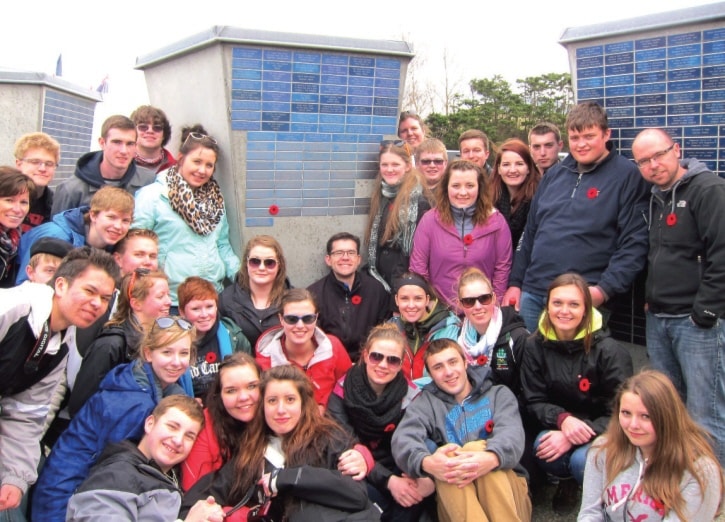Over the spring break, students with Ponoka Secondary Campus’ Broncs World Tour project trekked through Europe in an awe-inspiring journey to bring the stories of Central Alberta’s First and Second World War soldiers back home, as well as experience the scars and memories left over from the war.
The involved students immersed themselves in the past and how the sacrifices of counties, families and individuals ensured the freedom they experience.
The trip began in Amsterdam, Germany and Belgium, where several cemeteries and St. Julien Canadian Memorial were visited.
“It (the village of St. Julien) was the first place the Canadians got gassed in World War One,” said high school student Clinton Rodney. The village and surrounding wood was located at the bend of the Ypres Salient, where German forces unleashed thousands of cylinders of chlorine on Canadian troops.
Most of the student’s time was spent in France, where they toured many small towns on the way to Commonwealth cemeteries.
One of their most memorable experiences was the Last Post Ceremony at Menin Gate, which takes place every night at 8 p.m. “It was amazing to see how many people were there,” said Jaime Sweet.
“I thought it was amazing . . . For something that happened 100 years ago, it’s pretty humbling,” added Rodney.
The students also had the opportunity to see the Canadian National Vimy Memorial and the location of the Battle of Vimy Ridge, where they toured the trenches and underground tunnels as well as saw the “No Man’s Land” and the German frontline.
Rodney, Sweet and their fellow tour mates Jordan Vold and Shelbey Merrill were able to gain more perspective on how the soldiers lived. “No Man’s Land was really small. They had to section off half the whole place because there’s still live land mines,” said Rodney.
For the four students Vimy was the most emotional stop on the trip. They all agreed the area was overwhelmingly, breathtakingly beautiful. “It’s hard to wrap your head around a war had taken place there,” said Vold.
Sweet and Merrill both noticed the importance Vimy had for the students and how impacting it was on them. “The mood, when you get there, everyone is respectful,” said Sweet.
“That’s really how we got our independence was the Battle of Vimy. The whole monument is really beautiful. It doesn’t glorify anything we’ve done, it’s all about sacrifice,” Rodney added.
During the tour, beaches of Omaha and Juno were visited. At the Juno Beach Centre, a museum located in Courseulles-sur-Mer in Normandy, Broncs World Tour teacher Ron Labrie surprised the students with a plaque of the tour and their school that would remain at the centre.
“I thought that was really cool. Right now, the basis of our trip is to acknowledge those who fought,” said Merrill.
“It acknowledges us, that’s kind of nice,” Rodney added.
In the small French town of Bois-Heroult, the arrival of the Broncs World Tour was cause for celebration. In a field bordering the town, a plane of Canadian soldiers crashed, its crew including a soldier who has been the subject of a research by the school. A farmer managed to rescue five of the men and hid them in his house, away from the German.
“He was still living there when we went there,” said Rodney.
In attendance at the ceremony were the townspeople and mayor; Ponoka students sung O’ Canada at the edge of the crater where the plane crashed.
They were also given a tour of the mayor’s chateau, which the students say was a castle. In it was a fireplace gifted to the house by Canadians many years after the war ended as a token of gratitude. During the war, Canadian soldiers were kept hidden by the town in the attic, even though the Germans had a base camp in the house’s basement
Their time in Paris and Rome included day tours of inner Paris, where the Eiffle Tower and Arc de Triomphe sit, and in Rome the Colosseum, the Sistine Chapel and Vatican City.
Although most of the trip was spent visiting war memorials and cemeteries, the students were also given time to relax. “It was a good balance between serious and fun,” said Vold.
For each of the students, while they all experienced the same trip, it left different impacts on them. For Rodney, he walked away with an extrospective view. “I would say the understanding of what the Allied Forces went through during the world wars. It’s pretty mind blowing.”
For Merrill, the work on the soldier profiles is what she’ll remember most. Labrie told the students before they made the trip each of the soldiers was like the tip of an iceberg. “You get your soldier profile and research them for six months, you see the whole iceberg . . . You tell everyone of their life and what they sacrificed.”
“They’re not just the tip of the iceberg they’re a person,” she added.
“The biggest part for me was the importance of remembrance . . . They become a part of you. Getting to their grave was pretty emotional,” said Sweet.
The cemeteries had the largest effect on Vold. For some of the cemeteries and graves of Alberta’s men, the students were the first from central Alberta to have ever visited them. “There were a lot of soldiers on this trip Labrie’s never visited before. It was brand new.”
This didn’t surprise the students once they found out where some of the cemeteries were located. One was in a field so out of the way the students had to walk through a woman’s driveway and across the field to reach it.
